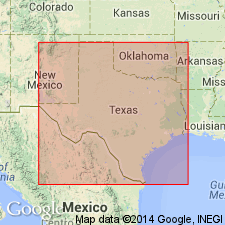
- Usage in publication:
-
- Word formation
- Modifications:
-
- First used
- Dominant lithology:
-
- Limestone
- Sandstone
- AAPG geologic province:
-
- Permian basin
Summary:
First use of name; intent to name not specifically stated, and no type locality designated. Found in the southern and southeastern hills of the Glass Mountains, Brewster Co, TX in Permian basin. [Probably named for Word ranch in the Glass Mountains.] Overlies Leonard formation and underlies Vidrio formation (both first used in this report). "In upper part Word is composed of thin- and thick-bedded gray and yellow to reddish limestone, in part dolomitic, containing chert concretions with some interbedded strata of sandstone (about 380 ft); below this we find some 120 ft of yellow sandstone, in part laminated. The lowest part of this formation consists of 120 ft of heavy-bedded gray limestone, with chert concretions. The entire thickness of this formation is approximately 600 ft." Is of Permian age. Geologic map [on which the Permian is shown undivided].
Source: GNU records (USGS DDS-6; Denver GNULEX).
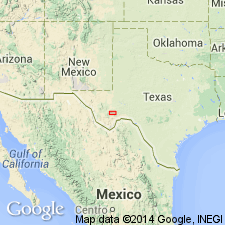
- Usage in publication:
-
- Word formation
- Modifications:
-
- Overview
- Dominant lithology:
-
- Shale
- AAPG geologic province:
-
- Permian basin
Summary:
579-792 ft thick in Glass Mountains, Brewster Co, TX, Permian basin; extends in a belt 1/4 to 1/2 mi wide, from Ord Range, crossing Southern Pacific just south of Altuda and extending under main escarpment of Glass Mountains past heads of Gilliam [Gilliland], Road, and Hess Canyons to beyond Pecos Co boundary, where it disappears beneath the Comanchean Cretaceous. Distinguishing feature in upper part of Word is presence of an arenaceous rock different from sandy members in the other Glass Mountains formations. rock changes from sandy limestone to calcareous sandstone in which sand is well sorted and fine grained. Usually evenly bedded and in places finely laminated. In places this phase of the rock is bituminous and shows sharply marked straight lamination. The cement renders rock firm and impervious. In middle of unit sand is coarser; often mixed with oolitic material. Lower part of unit consists mostly of shale with interbedded layers of sandstone and limestone; these sandstones are coarser than uppermost sandstone. Lower member consists of thin-bedded, bituminous, white-weathering limestone. 500 ft above base is a sandy, oolitic limestone with cephalopod fauna. Word belongs to Delaware deposits of Girty in Guadalupe Mountains. Also represents main part of Double Mountain in central TX. Conformably overlies Leonard and unconformably underlies Vidrio formations. Is Permo-Carboniferous. Fossil list. Geologic map, sections.
Source: GNU records (USGS DDS-6; Denver GNULEX).
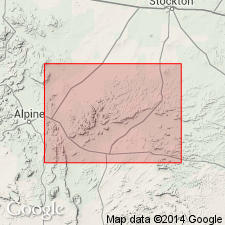
- Usage in publication:
-
- Word formation
- Modifications:
-
- Revised
- Overview
- AAPG geologic province:
-
- Permian basin
Summary:
Present in a belt extending northeast across the Glass Mountains, Brewster Co, TX in Permian basin. Also widely exposed in Del Norte Mountains, and is brought to the surface in Altuda Mountains uplift and Sierra Madera uplift. Conformably overlies Leonard formation and underlies Vidrio formation. Characterized by great lateral variation in thickness and lithology. Thickest to southwest; thins to north and northeast. Divided into an eastern and western facies, with transition taking place in region of Hess Canyon. Coarser sediments to southwest. Eastern facies: (ascending) cherty limestone, in part dense and bituminous, in part light gray and crystalline; siliceous shale, some quite sandy; interbedded limestone layers; about 300 ft below top is a persistent sandstone bed; at top is a buff sandy dolomite. Western facies: contains 4 thick limestone beds. Third bed from base contains rich ammonite fauna, the upper bed is quite cherty, and all are abundantly fossiliferous. Base is marked by a thin layer of platy bituminous limestone. Upper limestone member of Word distinguished from overlying Vidrio in that it is less massive and dolomitic, contains chert concretions, and is highly fossiliferous. Udden drew Word-Vidrio contact at base of member; authors here revise this contact and place the bed in Word formation in the western part of mountains. Contact is more gradational to northeast. Permian. Geologic map, sections.
Source: GNU records (USGS DDS-6; Denver GNULEX).
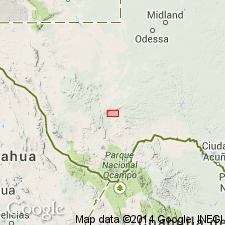
- Usage in publication:
-
- Word Formation*
- Modifications:
-
- Revised
- AAPG geologic province:
-
- Permian basin
Summary:
Lower contact of the Word Formation in Glass Mountains, Brewster Co, TX in the Permian basin revised in that it 1) overlies the newly named Cathedral Mountain Formation of Leonardian, Early Permian age, and 2) includes at base the newly named Road Canyon Member. The Road Canyon shown as extending from the Lenox Hill on the west to the Old World ranch on the east (cross section). The member was referred to as the "First limestone member" of the Word in earlier reports. Word assigned to the Guadalupian. [Upper part of Word not discussed.]
Source: GNU records (USGS DDS-6; Denver GNULEX).
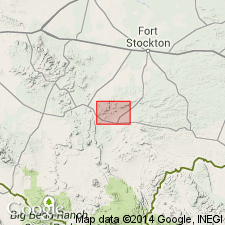
- Usage in publication:
-
- Word Formation*
- Modifications:
-
- Revised
- AAPG geologic province:
-
- Permian basin
Summary:
Word Formation revised in two ways. 1) It includes following newly named members in Glass Mountains, Brewster Co, TX in Permian basin (ascending): China Tank, Willis Ranch, and Apple Ranch [spelled Appel Ranch in subsequent reports] Members. 2) It overlies Road Canyon Formation (removed from Word Formation, rank raised to formation, and assigned to the Leonard Series). The three newly named members were formerly called "Second Limestone," "Third Limestone," and "Fourth Limestone" members of Word Formation (King, 1931); Road Canyon Formation was called "First Limestone" member. Word Formation underlies Capitan Limestone. Is of Permian (Guadalupian) age.
Source: GNU records (USGS DDS-6; Denver GNULEX).
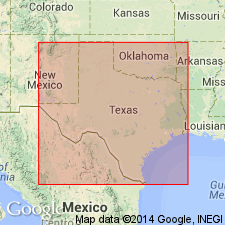
- Usage in publication:
-
- Word Formation*
- Modifications:
-
- Revised
- AAPG geologic province:
-
- Permian basin
Summary:
Word Formation revised in report area, eastern Glass Mountains, Brewster Co, TX in Permian basin in that it includes the following (ascending): China Tank Member, Willis Ranch Member, Appel Ranch Member, and Vidrio Limestone Member. [The inclusion of Vidrio is a change from the Word Formation as discussed by Cooper and Grant, 1966--they did not include Vidrio (or even discuss it.] On a restored section along the strike of the Glass Mountains (from southwest to northeast), these four members are present in the northeast portion of the Glass Mountains. Word overlies Road Canyon Formation and underlies Capitan Formation. Permian age.
Source: GNU records (USGS DDS-6; Denver GNULEX).
For more information, please contact Nancy Stamm, Geologic Names Committee Secretary.
Asterisk (*) indicates published by U.S. Geological Survey authors.
"No current usage" (†) implies that a name has been abandoned or has fallen into disuse. Former usage and, if known, replacement name given in parentheses ( ).
Slash (/) indicates name conflicts with nomenclatural guidelines (CSN, 1933; ACSN, 1961, 1970; NACSN, 1983, 2005, 2021). May be explained within brackets ([ ]).

